My own research on Steemit - seeking for new phenomena hidden in the properties of the Higgs boson [also in French: a la recherche de phenomenes nouveaux dans les mesures des proprietes du boson de Higgs]
The Large Hadron Collider (LHC) at CERN is currently searching for new particles beyond the Standard Model of particle physics. Due to null results, constraints on their existence are put in a stronger and stronger way. But what could we conclude from this if new phenomena would manifest themselves indirectly via tiny effects in the properties of the Standard Model particles, instead as via new particles to be directly observable?
This post covers my latest research work on the properties of the Higgs boson and the way the associated measurements could be used to indirectly discover (or constrain) new phenomena.
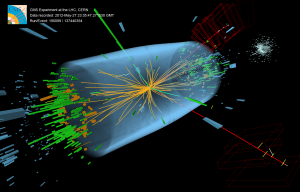 [image credits: the CMS collaboration]
[image credits: the CMS collaboration]
The original research article is freely available from the arXiv and will be submitted in the next few days to the European Physical Journal C, a SCOAP3 journal. The future published version of the article will be open access too.
TYPICAL BEYOND THE STANDARD MODEL SEARCHES AT THE LHC
Beyond the Standard Model investigations can be considered as a field of research itself. A specific class of high-energy theoretical physicists, called model-builders, are taking care of the design of new theories. Others then study the phenomenology associated with those theories and try to find ways to observe them in running experiments, in particular at the LHC (but not only).
The variety of existing proposals is illustrated in the picture below.
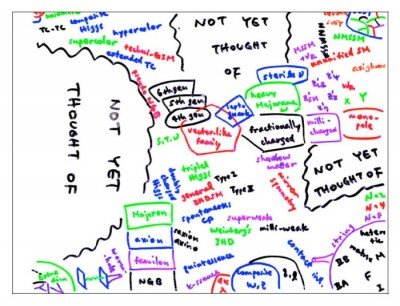 [image credit: ILC, from H. Murayama presentation]
[image credit: ILC, from H. Murayama presentation]
The most popular choices for beyond the Standard Model theories range from supersymmetric setups to compositeness theories, and also include models featuring additional spacetime dimensions or the grand unification of the fundamental interactions. And then comes many appealing options, very important but not as much studied as the formerly cited theories.
I will not describe all these theories (which I may however do in a future post).
The important point is that they all have a common feature: they predict the existence of new particles that can be seen as partners of the Standard Model particles with properties that can generally be inferred from the Standard Model.
If not too massive, those partners could possibly be observed at the LHC via specific distinctive signatures. This is what we referred to as searches for the direct observation of new particles.
However, not a single new particle has been directly observed so far, so that any partner from any physics theory beyond the Standard Model is in general constrained to be either heavy or with strange features that make it invisible.
WE NEED ALTERNATIVE METHODS TO SEARCH FOR NEW PHENOMENA
The current LHC results are what they are: nothing has been found so far.
For most of the beyond the Standard Model theories (or equivalently called new physics theories), the masses of the new particles are free parameters (or connected to the free parameters of the models) and can thus be tuned accordingly.
Therefore, a non-observation does not most of the time throw the theory to the graveyard but instead put constraints on their free parameters.
It is only when no option is left at all that we can consider burying a theory. In the light of recent LHC results, it is sufficient that all new particles are heavy to evade all existing further constraints.
And the new particles could be so heavy that they will not be directly observable at the LHC, even after 25 years of running.
Even if depressing, this is what exploration is about. We do not know what will be found and if we will find anything. We could also be unlucky: new particles exist but they are just too heavy to be observable at the LHC.
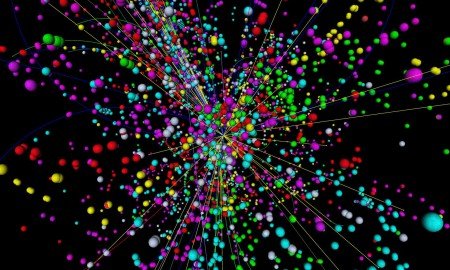 [image credits: CERN]
[image credits: CERN]
In this case, what are the good question to ask to ourselves? We know that the Standard Model must be the tip of the iceberg as a consequence of its flaws and defects. Is there thus an alternative way to probe for new phenomena, even if new particles are not reachable at the LHC?
A PRAGMATIC WAY FOR SEARCHING FOR NEW PHENOMENA
There is actually an alternative way to search for new phenomena. We have so far discussed direct searches for new particles, but we can as well rely on indirect searches. New particles are not accessible as the current machines are not powerful enough, but their existence however implies noticeable effects on the properties of the Standard Model particles.
Those indirect effects are however small, since we have not seen any of them yet, but they could be observable in future data.
The planned accumulation of LHC data implies that experimenters will soon be able to very precisely measure the properties of the Standard Model particles, so that we will be sensitive to very small deviations from the expectation.
There is however one caveat: the theoretical predictions must be as precise as the experimental measurements. And this is what my latest research article is about: precision in the theoretical predictions when tiny new physics effects on the properties of the Standard Model particles are accounted for.
In addition, we focus on a model-independent approach that is thus agnostic of the new physics theory under consideration.
In a previous post, I have mentioned that all the interactions we know are based on symmetries. Those symmetries are also indicating the form of all possible tiny deviations from the Standard Model particle properties, whatever is the physics model under consideration.
There is always only a very limited ensemble of ways in which the properties of the Standard Model particles can be modified.
PROBING THE HIGGS BOSON PROPERTIES FOR DEVIATIONS
We took five ways in which the properties of the Higgs boson could be modified and checked whether future data will allow us to observe associated deviations.
Then, we focus on two of the most important modes to produce a Higgs boson at the LHC, and started to investigate its properties. An example of results is shown in the figure below.
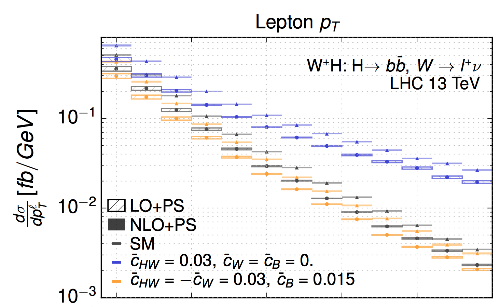
How to interpret this figure?
First, we consider a process where a Higgs boson is produced together with a W-boson, also known as Higgsstrahlung or the VH process. While the Higgs boson is considered to decay into a pair of bottom quarks (its most probable decay mode), the W-boson decays into a lepton (electron or muon) and an invisible neutrino.
On this figure, we focus on the properties of the lepton (that subsequently provide a handle on the Higgs boson properties). The figure show the distribution in the lepton transverse-momentum, or roughly how the lepton moves transversally to the collision axis (i.e. in the Oxy plane below).
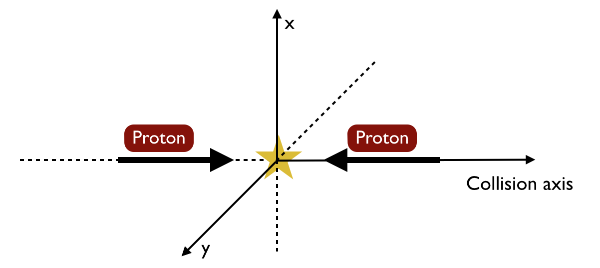
The figures represents the VH production rate as a function of the lepton transverse momentum. In short, how many WH events can be expected for a given value of the lepton transverse momentum.
On the figures, we have three series of two curves. Let us first investigate the lower ones of each series:
- The black curve represents the Standard Model expectation, or the results assuming no new physics.
- The blue and orange curves represent the predictions when two possible sets of deviations are included. The chosen deviations are sufficiently small for not having been observed up to now.
Comparing the three results, it is clear that a new physics scenario can potentially be distinguished from the Standard Model, provided that the experimental measurement is precise enough.
PRECISION PREDICTIONS
The curves have some thickness. Those consist of the theoretical uncertainties on the predictions.
In my previous post on Feynman diagrams, I have introduced particle physics calculations with and without loop diagrams. The set of lower curves are computed by neglecting any possible loop contribution, the results being thus approximated.
And this is what the three upper curves of the figure are about: they include quantum chromodynamics corrections (or the one-loop diagrams connected to the strong interaction, roughly speaking).
This leads to more precise predictions, which is one of the novelties of my article.
SUMMARY
We have followed a bottom-up way to probe new phenomena, parameterizing in five different ways deviations from the Standard Model that could be manifest in the properties of the Higgs boson. We have shown that deviations from the Standard Model are potentially observable, and have in addition increased the precision of the theoretical predictions.
Le Grand Collisionneur de Hadrons (le LHC) au CERN est actuellement a la recherche de nouvelles particules au-dela du Modele Standard de la physique des particules. En raison des resultats negatifs, des contraintes sur l’existence de telles particules sont imposees de plus en plus fortement. Mais que conclure dans le cas ou les nouveaux phenomenes se manifesteraient de facon indirecte, via des deviations de faible amplitude dans les proprietes des particules connues, au lieu d’etre visible directement via de nouvelles particules?
Cet article couvre mes dernieres recherches sur les proprietes du boson de Higgs et la facon dont les mesures associees peuvent etre utilisees pour decouvrir ou contraindre les nouveaux phenomenes.
 [image credits: the CMS collaboration]
[image credits: the CMS collaboration]
L’article original est disponible gratuitement sur le serveur arXiv et sera soumis dans les prochains jours a la revue European Physical Journal C, un journal participant a l’initiative SCOAP3. La version publiee de l’article sera ainsi egalement en acces libre.
RECHERCHES TYPIQUES DE PHYSIQUE AU-DELA DU MODELE STANDARD AU LHC
La physique au-dela du Modele Standard peut etre consideree comme un domaine de recherche en elle-meme. Une classe specifique de physiciens theoriciens des hautes energies, des constructeurs de modeles ou model builders en anglais, s’occupent de la conception de nouvelles theories. D’autres physiciens etudient alors la phenomenologie associee a ces theories et essaie de trouver des moyens d’observer ces theories aupres des experiences en cours, en particulier autour du LHC (mais pas uniquement).
La variete des theories qui ont ete proposees est illustree par l’image ci-dessous:
 [image credit: ILC, from H. Murayama presentation]
[image credit: ILC, from H. Murayama presentation]
Les choix les plus populaires pour des theories au-dela du Modele Standard consistent en des scenarios supersymetriques ou des theories composites, et incluent des modeles a dimensions spatiales supplementaires ou donnant lieu a une grande unification des interactions fondamentales. Et ensuite suivent tout un tas d’options tres attractives et importantes, mais pas autant etudiees que les theories citees ci-dessus.
Je ne vais pas decrire toutes ces theories (ce que je pourrais faire dans un article futur).
L’idee importante est qu’elles ont des proprietes communes: elles predisent toutes l’existence de nouvelles particules qui peuvent etre considerees comme des partenaires des particules du Modele Standard et dont les proprietes peuvent en etre deduites.
S’ils ne sont pas trop massifs, ces partenaires peuvent eventuellement etre observables au LHC via des signatures distinctives. C’est ce qui est appele une recherche de nouvelles particules par observation directe.
Cependant, pas une seule nouvelle particule a ete observee directement pour le moment, de sorte que n’importe quel partenaire d’une particule du Modele Standard est en general contraint d’etre soit lourd soit de posseder des proprietes etranges qui le rendent invisible.
IL NOUS FAUT DES METHODES ALTERNATIVES POUR RECHERCHER DES NOUVEAUX PHENOMENES
Les resultats du LHC actuels sont ce qu’ils sont: rien n’a ete trouve pour le moment.
Pour la plupart des theories au-dela du Modele Standard (aussi appelees de facon equivalente des theories de nouvelle physique), les masses des nouvelles particules sont des parametres libres de la theorie (ou sont connectees a ces parametres libres) et peuvent donc etre ajustees en fonction de ces contraintes.
De fait, une non-observation ne signifie pas, la plupart du temps, qu’il faut jeter la theorie a la poubelle, mais plutot qu’il existe des contraintes sur les parametres de la theorie.
C’est seulement quand aucune possibilite n’est disponible que nous pouvons considerer l’enterrement de la theorie. A la lumiere des resultats recents du LHC, il est en fait suffisant que les nouvelles particules soient massives pour echapper a toutes contraintes supplementaires.
Et les nouvelles particules peuvent etre telleent lourdes qu’elles ne pourront pas etre observables au LHC, meme apres 25 annees de fonctionnement.
And those particles could be so heavy that they will not be directly observable at the LHC, even after 25 years of running.
Meme si cela est deprimant, c’est de l’exploration. Nous ne savons pas ce qui pourra etre trouve et si nous trouverons quelque chose. Mais nous pourrions tres bien etre malchanceux: les nouvelles particules existent mais sont juste trop lourdes pour etre observables au LHC.
 [image credits: CERN]
[image credits: CERN]
Dans ce cas, quelle est la bonne question a se poser ? Nous savons que le Modele Standard n’est que la partie visible d’un iceberg en raison de ses defauts. Y a-t-il donc une facon alternative pour rechercher les phenomenes nouveaux dans le cas ou les nouvelles particules sont lourdes ?
UNE FACON PRAGMATIQUE POUR RECHERCHER LES PHENOMENES NOUVEAUX
Il existe en fait une facon alternative pour rechercher les phenomenes nouveaux. Nous avons pour le moment discute de la recherche directe de nouvelles particules, mais nous pouvons aussi effectuer des recherches indirectes. Les nouvelles particules ne sont pas accessibles a l’aide des machines actuelles, mais leur existence implique des effets visibles sur les proprietes des particules du Modele Standard.
Ces effets indirects sont cependant petits, vu que nous en avons vu aucun jusqu’a present. Ils peuvent cependant etre eventuellement observables dans les donnees futures.
L’accumulation planifiee de donnees au LHC implique en fait que les experimentateurs seront bientot capable de mesurer tres precisement les proprietes des particules du Modele Standard, de sorte que nous serons sensible a de tres petites deviations.
Il y a un seulement un hic : les predictions theoriques doivent etre aussi precises que les mesures experimentales. Et c’est le sujet de mon article scientifique: la precision des predictions theoriques quand des deviations minuscules dans les proprietes des particules du Modele Standard doivent etre prises en compte.
De plus, nous allons nous baser sur une approche independente de tout modele qui ignore toute theorie de nouvelle physique specifique.
Dans un post precedent, j’ai mentionne que toutes les interactions que nous connaissons sont basees sur des symetries. Ces symetries nous indique egalement la forme possible de toute petite deviation du Modele Standard au niveau des proprietes des particules, quelque soit le modele de physique en consideration.
Il y a toujours seulement un nombre de facons restreint dont ces proprietes peuvent etre modifiees.
INSPECTION DES PROPRIETES DU BOSON DE HIGGS A LA RECHERCHE DE DEVIATIONS
Nous avons pris cinq facons selon lesquelles les proprietes du boson de Higgs peuvent etre modifiee et verifie que les donnees futures vont permettre d’observer les deviations associees.
Ensuite, nous nous sommes concentres sur deux des modes de production du boson de Higgs au LHC les plus importants, et etudie ses proprietes. Un exemple de resultats est montre ci-dessous.

Comment interpreter cette figure?
Tout d’abord, nous considerons un processus ou un boson de Higgs est produit en association avec un boson W, aussi connu sous le nom de Higgsstrahlung ou le processus VH. Tandis que le boson de Higgs est considere comme se desintegrant en une paire de quarks bottom (son mode de deinstegration le plus probable), le boson W est pris comme se desintegrant en un lepton charge (un electron ou un muon) et un neutrino invisible.
Sur cette figure, nous etudions les proprietes du lepton (qui nous donne un moyen de remonter jusqu’aux proprietes du boson de Higgs). La figure montre la distribution en impulsion transverse du lepton, ou en gros comment le lepton se deplace de facon transverse a l’axe de la collision (c’est-a-dire dans le plan Oxy de la figure ci-dessous).

Le graphique nous montre donc le taux de production pour le processus VH en fonction de l’impulsion transverse du lepton. En gros, combien d’evenements WH peuvent etre attendus pour une valeur donnee de l’impulsion transverse du lepton.
Sur cette figure, nous avons trois series de courbes. Concentrons-nous uniquement sur la courbe inferieure de chaque serie.
- En noir, nous avons la prediction du Modele Standard, quand il n’y a donc pas de nouvelle physique.
- En bleu et en orange, nous avons choisi deux jeux de deviations possibles. Ces deviations sont suffisament petites pour ne pas avoir ete observees jusqu’a aujourd’hui.
En comparant les trois resultats, il est clair qu’un scenario de nouvelle physique peut potentiellement etre distingue du Modele Standard si la mesure experimentale associee est suffisament precise.
DES PREDICTIONS PRECISES
Les courbes ci-dessus on une certaine epaisseur. Cette epaisseur consiste en ce qu’on appelle les incertitudes theorique sur les predictions.
Lors de mon article precedent sur les diagrammes de Feynman, j’ai introduit les calculs de physique de particules avec et sans boucle. Les courbes inferieures correspondent a un calcul sans boucle, ou les resultats sont approches.
Pour les trois autres courbes que nous n’avons pas encore regardees, les corrections de chromodynamique quantique sont inclues (en gros, les diagrammes a une boucle lies a l’interaction forte).
Cela mene a des predictions plus precises, qui est l’une des nouveautes de mon article.
RESUME
Nous avons suivi une approche de type bottom-up pour la recherche de physique au-dela du Modele Standard, en parametrant de cinq facons differentes comment des phenomenes nouveaux pourraient affecter les proprietes du boson de Higgs. Nous avons montre que des deviations du Modele Standard sont potentiellement observables, et avons ameliore la precision des calculs theoriques.
REFERENCES
- arXiv:1609.04833, Electroweak Higgs boson production in the standard model effective field theory beyond leading order in QCD, submitted for publication in the European Physical Journal C (a SCOAP3 open access journal).
Much respect my friend! I am a student of science (biochemistry and nanotechnology) and this is truly amazing. I hope to make one day some researches on my own :) Following you
Thanks for your kind message :)
how much time does it take to prepare for an experiment to produce a Higgs boson?
The first discussions about the LHC were in 1986. It was built during 20 years before starting in 2009. It will be operated probably until 2035. That gives you an idea of the order of magnitude...
The particle physics community is actually discussing the next machines, and one option could be a Higgs boson factory (there are actually several options discussed so far, like a larger circular collider to be built either at CERN or in China, or a linear collider that could be built in Japan). For the moment, the physics options of such machines are being identified, the technology to use is being discussed, early-stage R&D is on-going, etc.
We will need to wait a bit before seeing one of these projects approved (if this actually happens). First a community-based decision, and then the politics will have to be convinced... If this works, maybe will the machine be ready in 20 years. Maybe later...
this scale is unimaginable. to provide an outsider's perspective, I'd be more optimist and assume that other technologies evolve and emerge that may help accelerating these developments in physics.
New technologies can emerge, but the R&D will have to be frozen at some point. But the developments necessary to achieve the physics goals will in any case lead to new non-patented inventions. Therefore free for the society :)
I started to read, but realized I have to bookmark it for the evening (probably couple of evenings:)) to concentrate and understand it!
Very interesting, as always - thank you for sharing your knowledge with us, @lemouth!
Thanks a lot! Yeah it may be a little bit long. But it is hard to explain it in a shorter way. If you have questions, do not hesitate to pass by the steemit chat (#science).
Thank you!
I'd better not spam the chat with the silly questions, but will be interesting to read the discussions there) will join!
There are actually not too many discussion (if any) on the chat... It is more a collection of advertisements so far. But we are working on that ;)
Thanks for sharing, resteemed and upvoted :)
Thanks a lot!
Un article excellent, merci beaucoup de partager de ce monde avec nous tous. Tous pour un et un pour tous! ;) Namaste :)
Tout le plaisir est pour moi (ou en tous cas une partie du plaisir)! :)
Replying to read this in more detail @lemouth, its been a busy day but I will get back to it! Will edit this comment with questions when I do.
Edit:
So the work in this paper is theoretical predictions? Also can you explain the units on the Y-axis of your lepton plot? Forgive me if this should be obvious... I am just entirely unfamiliar with this sort of material! :)
Minor Corrections " We took five way..." way should be ways, later in that same sentence, check should be checked (for tense agreement).
I am indeed only talking about theoretical predictions. Showing that various hypotheses (all in agreement with current data) for the beyond the Standard Model setup give predictions that can be potentially distinguishable from each other.
Going back to the figure, let's start with the caption below (the collision in the Oxyz frame). The two protons collide following the Oz axis. They will fragment in strongly interacting pieces that will radiate and decay so that the z-direction will be full of particles. Any measurement along this direction is thus impossible. That is why we are focusing on what is happening in the transverse plane (the Oxy plane). Our process is
p p > W H > (l vl) (b b~)
The W decays into a lepton (l) and a neutrino (vl). The Higgs boson decays into a bottom (b) - antibottom (b~) pair. As we cannot measure anything following the Oz direction, we will project the momentum of the decay products in the Oxy plane. The transverse momentum is the norm of this 2D vector:
pt = sqrt(px^2 + py^2)
and pz is not measured. Is it clearer?
Thanks for the corrections ;)